Samsung Epic 4G Review: The Fastest Android Phone
by Anand Lal Shimpi on September 6, 2010 5:28 PM EST- Posted in
- Smartphones
- Samsung
- Epic 4G
- Gadgets
- Mobile
The Display: Like AMOLED, but Super
Did I mention Samsung also makes displays? The Epic 4G and the rest of the Galaxy S line are among the first to use a new type of active matrix OLED called Super AMOLED. The main difference appears to be that the capacitive touch layer and AMOLED are now integrated rather than laying on top of one another. This sounds a lot like the manufacturing technique used in Apple’s Retina Display. It’s supposed to reduce unwanted glare/reflections and improve the efficiency of the display.
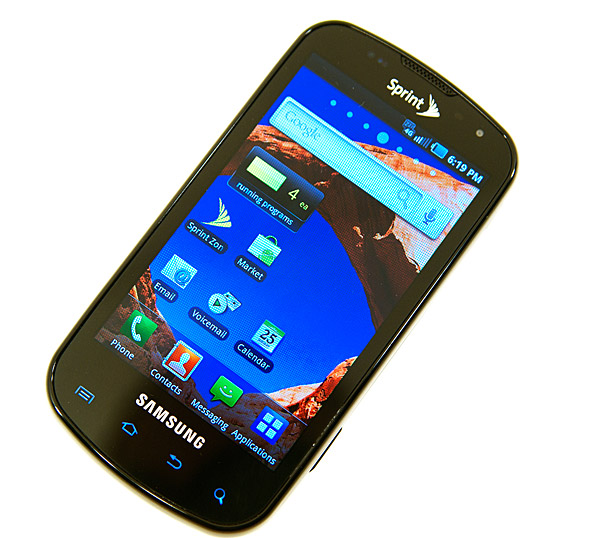
The end result is very noticeable. The Epic 4G is much easier to read outdoors compared to the original AMOLED Android phones like the Nexus One:
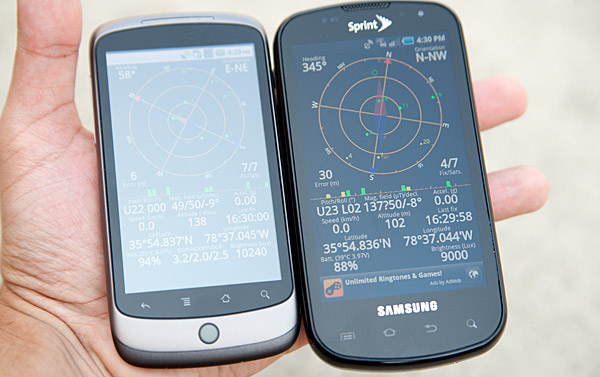
Google Nexus One AMOLED (left) vs. Samsung Epic 4G Super AMOLED (right)
The Super AMOLED display is a nice improvement over the standard AMOLED. I’d even go as far as to say that it’s comparable to most LCDs in direct sunlight, at least when you’re looking at things that aren’t white. Displaying white is a problem for AMOLED screens, it eats up a ton of power since the technology is emissive without the use of a backlight.
Direct Sunlight
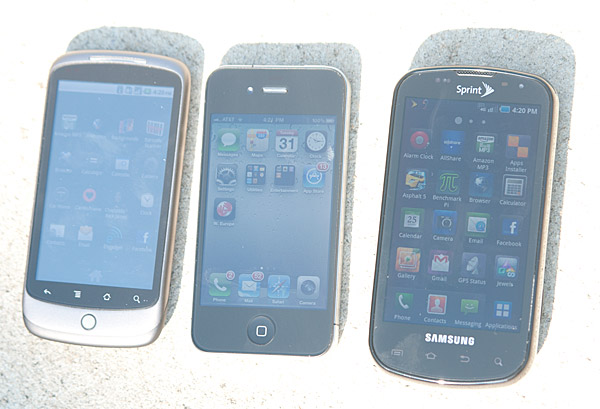
From left to right: Google Nexus One, Apple iPhone 4, Samsung Epic 4G
Shaded, Outdoors
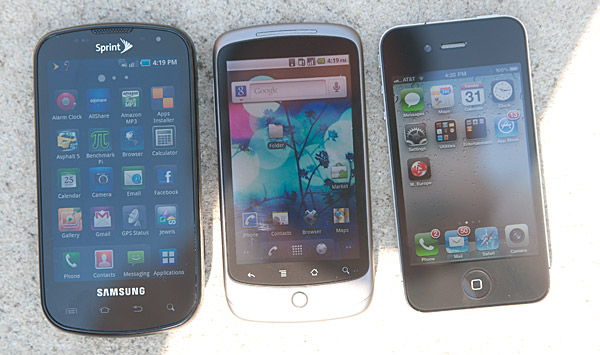
From left to right: Samsung Epic 4G, Google Nexus One, Apple iPhone 4
The biggest selling point of AMOLED is its deep blacks, which the Epic 4G’s display delivers perfectly. The display is almost too contrasty. The bright blue text on black background in the settings pages just pops.
Brightness is an issue with the display. The brightest white I measured was only 300 nits:
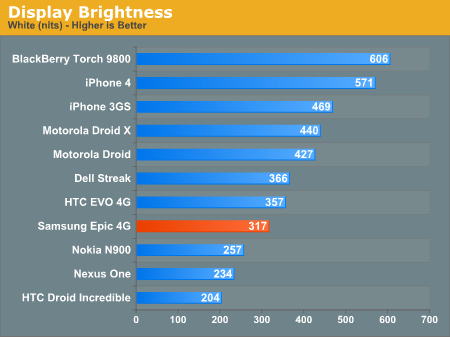
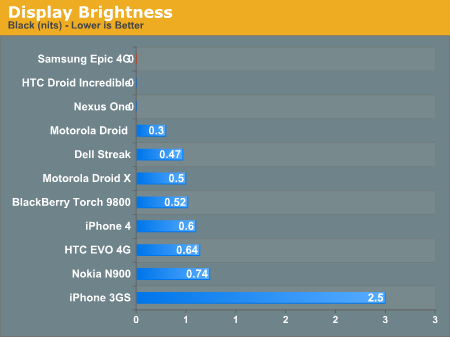
Samsung gets away with a relatively dim device by having perfect black levels, but the display’s weakness is visible when reading web pages with mostly white backgrounds.
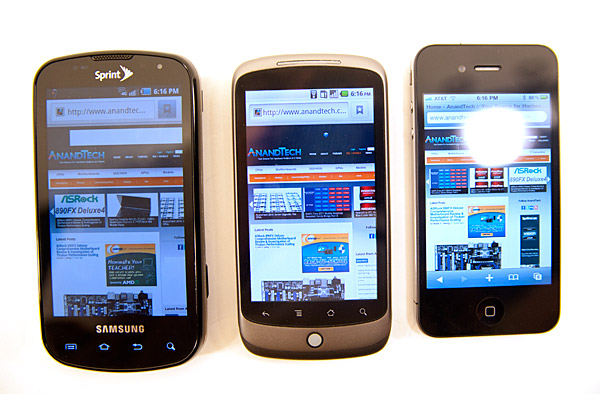
From left to right: Samsung Epic 4G, Google Nexus One, Apple iPhone 4
In the photo above, the Nexus One looks brighter, but the Epic 4G's white levels measure higher. I suspect this may be a Super AMOLED vs. AMOLED issue with our x-rite colorimeter. In practice the Nexus One has brighter pure whites while the Epic 4G has a brighter display in any other situation (e.g. home screen).
As AdamPflug correctly pointed out, the Epic 4G's web browser has a separate brightness setting which explains the difference in brightness above in the browser. In this case the brightness was set to around 20% of maximum on the Epic 4G.
Samsung includes a dynamic display feature that reduces brightness depending on the contents of the screen (there’s also the standard auto brightness based on ambient light). It’s not that noticeable when turned on in most situations but it reduces maximum brightness by about 100 nits. Again, this is mostly an issue with web pages that have a lot of white in them.
I’d say Samsung’s Super AMOLED is in the running for best display on a smartphone up there with the iPhone 4’s Retina Display. Apple has the resolution advantage, but Samsung has a huge contrast advantage. The former is nicer for reading text, while the latter is better for just about everything else.
Even if you don’t get the Epic 4G, Super AMOLED displays are where it’s at. They’re far more usable outdoors and you still get the contrast benefits of AMOLED.










93 Comments
View All Comments
MJinZ - Monday, September 6, 2010 - link
It's an interesting review since it starts out with some good words and ends with, what my impression is - well it's a POS.And I'm sorry Samsung, but a phone needs to last more than 5 minutes and a GPS needs to work. We really could not care about it looking like a damn iPhone. Hell, people buy iPhones for that.
Try harder Sammy.
zizagoo - Monday, September 6, 2010 - link
There seems to be an agreement amongst high-end Android users that battery life is terrible within the first two weeks, but then significantly improves after the battery has been conditioned. It's possible that due to the short review period, this never get's a chance to happen, causing an under report of the battery life.It would be fascinating if you did a follow up later on to determine if this is true.
StealthX32 - Monday, September 6, 2010 - link
The functional battery life is pretty long. I can pull 1.5-2 days if my use is limited (maybe 20 minutes of calling, 20 or so text messages, little to no browsing). The Hummingbird really does sip power when it's idle.If you're hammering away at it for 4 straight hours, then the battery life is pretty poor.
strikeback03 - Tuesday, September 7, 2010 - link
But other than emergency situations, are you really going to have a phone like this and only use it that little? I've mentioned before, I wish they could come up with some type of "real-life" battery test that would include a certain amount of talk, text, web, video, etc. per hour. For example, I would be surprised if the battery in my HTC Diamond lasts much more than 2 hrs in 3G browsing, but in my usual day (5-10 min talk, 80-100 text, few MMS, 10-15 min web, many times turned on to check the time) it generally has 20-30% still showing when I put it back on the charger after 15-16 hrs.Dane74 - Monday, September 6, 2010 - link
On battery break in: with Lithium based batteries, break in is negligible. The observed better second week battery life comes from playing with less features.I expected better battery life than my spouse's Evo, due to more efficient power usage of the Epic's processor as well as its screen. We found the battery life to be equal, my impression from behavior of both in weak signal areas is that Epic's voice, 3g and its 4G reception is slightly worse than Evo which will cause some additional drain on power.
gvaley - Tuesday, September 7, 2010 - link
My personal experience (6+ device batteries so far, including phones, cameras) shows a 1,8-2x battery life improvement after 3-4 charge-discharge cycles. And it's definitely not due to unbalanced usage. The same holds true for both Lithium-Ion and Lithium-Polymer batteries, although the more I think about it, the more I convince myself that Lithium-Polymer are more susceptible to break in.Ratman6161 - Tuesday, September 7, 2010 - link
I've got an original Droid now running Android 2.2. A while back I picked up a couple of spare batteries cheap online. These are identical to the one that came in the phone. When I swapped in one of the new batteries it was showing up as fully charged already. I started rotating the three batteries every Friday to keep approximately equal usage on each one.I never really noticed any difference. Then again I wasn't specifically looking for that and did not do any kind of test.
AdamPflug - Monday, September 6, 2010 - link
I have the Samsung Captivate (not the Epic 4G), but it's still in the galaxy S line. I noticed that I needed at least 3 complete charge/discharge cycles before I got reasonable battery life out of the phone. It wasn't a decrease in usage either, I made sure I kept my usage patterns consistent.My experience with the Captivate now is that I can listen to podcasts all day, read all my work email, do some web browsing, and still have around 60% battery left at 10pm. If they could just fix the GPS issues with a software patch (they say they're going to sometime in September, along with an upgrade to 2.2) the I'll be extremely happy.
Also, I've been pretty happy with the brightness of my Captivate, I wonder if the review took into account the separate brightness settings for the browser app?
Anand Lal Shimpi - Tuesday, September 7, 2010 - link
These results were all recorded after discharging the phone more than 3 times (each test was run multiple times). Note that 4 hours of continuous usage can often times yield a pretty long real world battery life depending on your usage pattern. That being said, a phone that gets 8 hours in our tests will obviously last longer with the same usage pattern. While the Epic 4G's battery life may be sufficient, it's lower than we'd like to see for a modern smartphone.And thank you for the correction on the browser brightness setting, that's why the screen looked dimmer at full brightness by comparison. In that shot the Epic 4G's screen was set to approximately 20% brightness. I've made the appropriate correction in the review and credited you with the heads up :)
Take care,
Anand
gvaley - Tuesday, September 7, 2010 - link
Anand, the poor battery life is probably due to Sprint. Other reviews (of the European 3G galaxy S) show maybe the best battery life among Androids. Check this test from a very reputable site: http://blog.gsmarena.com/samsung-i9000-galaxy-s-fu...